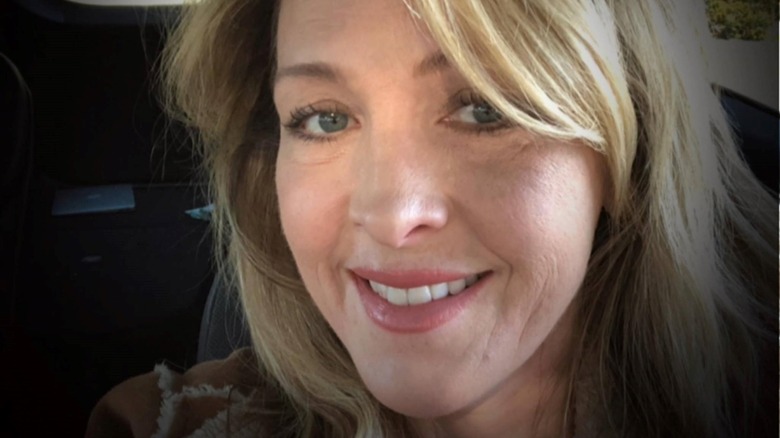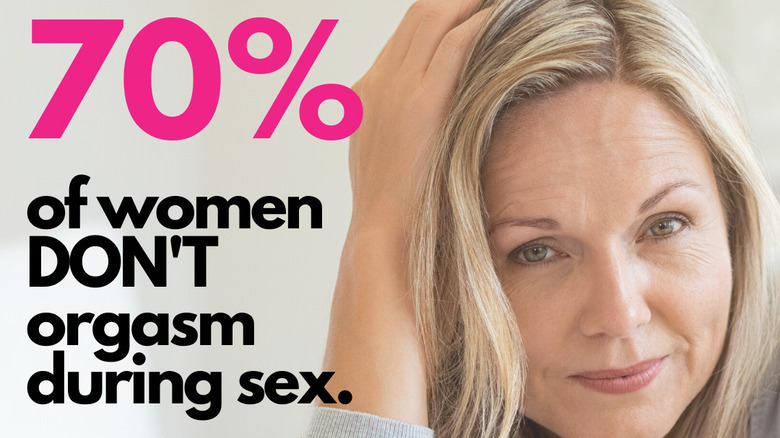OB-GYN And Sex Expert Dr. Caroline Colin On The Orgasm Gap And Having Better Orgasms - Exclusive Interview
According to Dr. Caroline Colin, having good sex is just as important for our overall health as eating a balanced diet and exercising. Unfortunately, the majority of people with female anatomy aren't having good sex. While 75% of people with male anatomy orgasm during each sexual encounter, only 33% of people assigned female at birth orgasm during sexual encounters with people of the opposite sex — and 30% have trouble achieving orgasm at all. Sometimes this is due to female sexual dysfunction, but all too often, it's due to a lack of knowledge about the female orgasm and how to make it happen.
Luckily, there are a lot of things people with female anatomy and their partners can do to increase their chances of orgasming during each sexual encounter. In an exclusive interview with Health Digest, Dr. Colin revealed how to increase the chances of orgasming during every sexual encounter and how an innovative form of therapy can help.
Changing the way women view sex
Can you tell us a bit about your career? Why did you choose OB-GYN as a specialty?
In college, I studied psychology and became fascinated with the mind-body connection. I wanted to empower people, and after studying physiology and biophysics in grad school, decided that a career in women's health was where I could make the most difference. I have used a complementary approach from my days in medical school at Georgetown where we planted a medicinal garden and incorporated acupuncture in the anatomy curriculum to my current private practice in Santa Monica, California. Being a gynecologist allows me to see a woman throughout their lives and work with them to live their best lives.
How did you get interested in studying sex and pleasure, especially for people with female anatomy?
Sexuality is a fundamental need [for] maintaining health and living your best life. We live in a puritanical society that has left women feeling ashamed of sexual needs and uncomfortable about needing and wanting pleasure. A satisfying sex life is as basic as nutrition, exercise, and sleep, but it is ignored or — even worse — frowned upon. I talk about sex like I talk about breathing — fundamental to a healthy life.
How did your research lead you to become a Cliovana practitioner?
Women should be enjoying sex at all stages of their lives, and I encourage women to take back their sex life, as this can have a profound effect on women's overall health, wellness, and happiness. While there are many ways to treat libido changes due to menopause and female sexual dysfunction post menopause, the most exciting is a treatment called Cliovana: a gentle, non-invasive alternative to rejuvenation surgery. It is a game-changer! So many women don't enjoy a healthy sex life and suffer alone quietly. It's easy to get scared away by the thought of lasers, surgery, needles, and probing. With Cliovana, female sexual wellness is normalized with a quick and painless procedure.
How Cliovana helps women have better orgasms
Can you tell us more about the Cliovana soundwave therapy and how it can help people achieve orgasm?
Cliovana is the latest non-invasive soundwave technology to address sexual dysfunction and enhance female orgasms. Cliovana works at the cellular level, allowing your body to do what it does best — naturally. Cliovana is designed to increase women's long-term sexual responsiveness and allows for more intense, more frequent orgasms for women. This patented soundwave technology maximizes clitoral responsiveness to stimulate sexual satisfaction, orgasm, intensity, frequency, arousal, and lubrication.
This is done with the use of soundwaves, which have been used to treat a wide variety of soft tissue issues for 40 years. The soundwaves induce microscopic trauma in tissue, which then stimulates the body's natural processes for healing. This creates neurogenesis and neovascularization — or in layman's terms, new blood vessels and nerve endings. Simply put, the sound wave technology boosts the process of regenerating cells in the genitals, resulting in improved blood flow to the clitoris, which increases sensitivity, all leading to more orgasms.
This quick session is approximately 10 minutes and is done four times over two weeks. The process includes three gentle steps:
- Step 1: Cupping provides a mild pulsing suction that draws the blood to the surface in preparation for soundwave treatment.
- Step 2: Acoustic sound waves are transmitted through one of the two transmitter heads, and they are responsible for enhancing revascularization and neurogenesis of the clitoris.
- Step 3: The second transmitter head uses a combination of vibration and soundwaves and is used to help calm the area and allow it to take in the full effect of the treatment.
This quick session is approximately 10 minutes and is done four times over two weeks. The results are often felt immediately and intensify over three months. Best of all, these effects last for a year or more and can be sustained with an annual revitalization session of two 10-minute treatments.
Equalizing the orgasm
Let's talk about the orgasm gap. What does that term refer to?
The orgasm gap, also known as orgasm inequality, refers to the disparity in orgasms between couples. The pinnacle of sexual pleasure is the orgasm, but sadly, the pleasure gap is real: Only 33% of women reach an orgasm every time during male-female sexual encounters versus 75% of men, and 30% of women have trouble climaxing at all.
Satisfying sex is an essential part of both a man's and a woman's overall physical and emotional well-being at any age. With so much attention on men's sexual health this past decade, it's about time the focus shifted to women's sexual health and dysfunction.
Why do people with female anatomy have a harder time reaching climax?
Firstly, sexual dysfunction is nothing to be embarrassed about. Many people with female anatomy experience some form of it, with studies showing that 60% of women are dissatisfied with their sex life.
For any person going through menopause, sexual dysfunction is enhanced. For many women, a major casualty of the menopause-related problems is the loss of a healthy and fulfilling sex life and losing intimacy with a partner — all of which exacerbate an already difficult emotional time in women's lives. Furthermore, with the decrease of key hormones such as estrogen, the vagina's natural lubrication is no longer maintained, and the elasticity and thickness is impacted. This all contributes [to] sexual dysfunction.
Does the orgasm gap exist for partners that both have female anatomy?
No — interestingly, lesbian women report reaching orgasm with every sexual encounter 86% of the time, as compared to only 66% for bisexual and 65% of heterosexual women. Men, whether heterosexual (95%), bisexual (89%), or gay (88%), had much higher rates of always orgasming.
Understanding female orgasms
What role does the clitoris play in orgasm?
The sole function of the clitoris is the female orgasm. The clitoris is a fascinating part of the female anatomy, with its only purpose being to provide pleasure. That's it. It is there to make us feel good. The clitoris is located above the vaginal opening, and you can only see a small part of the clitoris, as the majority of it is internal. For women and people with vaginas, orgasms most commonly come from the clitoris, and it is the primary source of female sexual pleasure.
What's the difference between a clitoral orgasm and a vaginal orgasm?
Clitoral orgasms are the most common of all female orgasms. 70-80% of people with vaginas need direct clitoral stimulation, either with a toy, fingers, tongue, or the right position that hits the spot. Most women orgasm faster via clitoral stimulation, as the clitoris has more nerve endings than any other human body part, male or female. Vaginal stimulation can also trigger orgasm.
Having better orgasms every time
Which kind of orgasm is more pleasurable for most people?
Most women experience orgasms originating from the clitoris, whether through direct stimulation or from penetrative sex. These are considered the most pleasurable and intense. There are 8,000 nerve endings in the clitoris, so this is not surprising.
How does communication factor into having better sex?
Sexual dysfunction is often caused, in part, by relationship factors. Counselors and sex therapists can help you approach the problem from that angle, while the medical aspect can be handled individually. Communication in any relationship is vital, especially when it comes to sexual pleasure between partners.
What's your overall advice for someone who wants to have better sex and achieve orgasm every time?
I want that person to optimize their anatomy and their psychology to achieve the best orgasms possible. Cliovana has made an incredible difference for my patients who benefit from increased blood flow and sensitivity. They have more intense and more easily attainable orgasms. Directed masturbation, partner play/communication, and mutual masturbation can all lead to a more comfortable and familiar exploration. When you are primed, amazing orgasms are so easy!
For more information about how Cliovana can help you have better orgasms, check out their site at www.cliovana.com.
This interview was edited for clarity.





